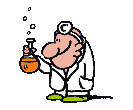Units of Study

Our course is
divided into 9 basic units of study. These
units are
developed from the April 2005 edition of the Louisiana
Comprehensive Curriculum for Chemistry.
Below
are the things you
should be able to do by the conclusion of the course.
Each unit is linked to a page with specific
topic information, practice problems, practice quizzes, and extra
online
learning activities you will need. Check
it out!
Unit 1: Measurements and Problem
Solving
Learning
Objectives:
- use lab safety procedures
correctly and consistently
- explain the importance of
standard units of measurement
- determine the precision
of a measuring instrument and relate the number of significant figures
to that precision
- apply scientific method
and reporting to simple problems
- Identify the basic areas
of chemistry study
- name and give symbol of
basic elements
- explain how measurements
may be precise but not accurate
- demonstrate knowledge of
expressing numbers in correct scientific notation and significant
figures in experimental calculations and other problem-solving
situations?
- use the factor-label
method of solving problems to perform metric conversions
- convert measured
quantities into other standard units
Learning
Objectives:
- describe, differentiate,
and provide examples of elements, compounds, and mixtures
- describe, differentiate,
and provide examples of physical properties, physical changes, chemical
properties, and chemical changes
- determine if a substance
is a metal, nonmetal, or metalloid, based on properties and location on
the periodic table
- use knowledge of physical
properties and changes to separate an unknown mixture
Unit 3:
Atoms and Elements
Learning
Objectives:
- trace the development of
the atomic theory through modern times
- represent the structure
of the atom using a variety of models
- predict the physical
properties, chemical properties, and bonding potential of an element
based on its location on the periodic table and provide the rationales
for the predictions
- differentiate between
mass number and atomic mass and relate these terms to isotopes of
elements
- identify the types of
radiation and radioactive decay and give an example of each
- explain what is meant by half-life of a radioactive substance
- describe the benefits of
using radioactive substances
Unit 4:
Language of Chemistry
Learning
Objectives:
- experimentally determine
a chemical formula of a compound
- determine chemical
formulas by using the periodic table
- determine multiple
oxidation numbers for an element
- express chemical
reactions using correct, balanced formula equations
- describe the mole as a
counting word/quantity and demonstrate the ability to solve mole
conversion problems
Unit 5:
Compounds and Solutions
Learning
Objectives:
- explain the difference
between mixtures and solutions
- demonstrate their
knowledge of various concentration units through problem solving that
involves real and hypothetical solutions
- predict and determine the
conductivity, freezing point, and boiling point from the known
concentration of a solution
- predict the bond type and
molecule shape of a compound
- predict the physical and
chemical properties of a substance based on the type of bond and
intermolecular forces present in the substance
Chapter
2: Matter and
Change
Chapter 15: Ionic Bonding and Ionic Compounds
Chapter 16:
Covalent Bonding
Chapter 17:
Water and Aqueous Systems
Chapter 18:
Solutions
Unit 6:
Reactions
Learning
Objectives
- identify the basic types
of chemical reactions
- write balanced chemical
equations
- explain the law of
conservation of mass in ordinary chemical reactions
- use balanced equations to
solve mass/mass, mass/volume, volume/volume, and mole/mole problems
- predict
the products of simple reactions, including acid/base,
oxidation/reduction, and
formation of precipitates
- describe Le Chatelier’s
Principle
- discuss environmental
issues related to the use and storage of chemicals
Unit 7:
Change and Energy Transfer
Learning
Objectives:
- predict the behavior of a
known quantity of gas using Boyle’s law, Charles’s Law, Gay Lussac’s
Law, Avogadro’s Law, and the Ideal Gas Law
- describe the experimental
study known as calorimetry and how it incorporates specific heat and
latent heat of fusion or vaporization
- compare the amount of
activation energy for an endothermic reaction and an exothermic reaction
- produce and interpret a
temperature-time graph as a substance passes through phase changes
Chapter
10: States of
Matter
Chapter 11:
Thermochemistry--Heat and Chemical Change
Chapter 12:
The Behavior of Gases
Unit 8:
Acids and Bases
Learning
Objectives:
- explain the meaning and
use of pH
- demonstrate knowledge in
calculations involving pH, pOH, [H+], and/or [OH-] of strong acids and
strong bases
- describe the process of
acid-base titrations and demonstrate knowledge application through
experimental calculations
- describe the role of
indicators in acid-base titrations and select appropriate indicators
for various pH ranges in experimental situations
Chapter
20: Acids and
Bases
Chapter 21:
Neutralization
Unit 9: Carbon and Its Compounds
Learning
Objectives:
- explain the differences
between diamonds and graphite
- describe the
hybridization of the carbon atom to explain single, double, and triple
bonds as well as molecular shapes
- classify, name, and draw
structural formulas for carbon compound molecules
- classify, name, and draw
structural formulas for carbon compounds with different functional
groups
Chapter 25: Hydrocarbon Compounds
Chapter 26: Functional Groups and Organic
Reactions
Chapter 27: The Chemistry of Life
Grant High School
17779 Hwy 167
Dry Prong,
LA 71423
Ph 318-899-3331
email: kathryn.yocum@gpsb.org
This site is © Copyright Kathy Yocum
2005-2006, All Rights Reserved.
Updated Aug 2005
Free website
templates
|
 |


